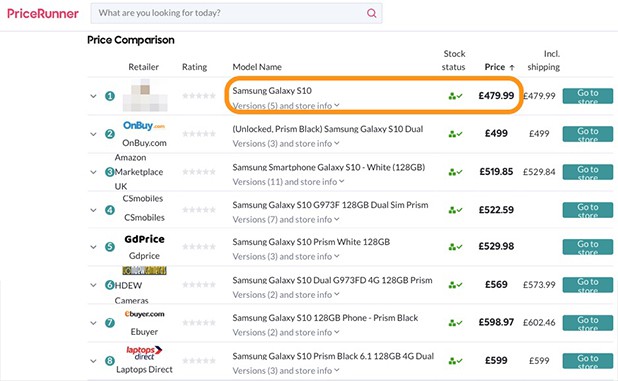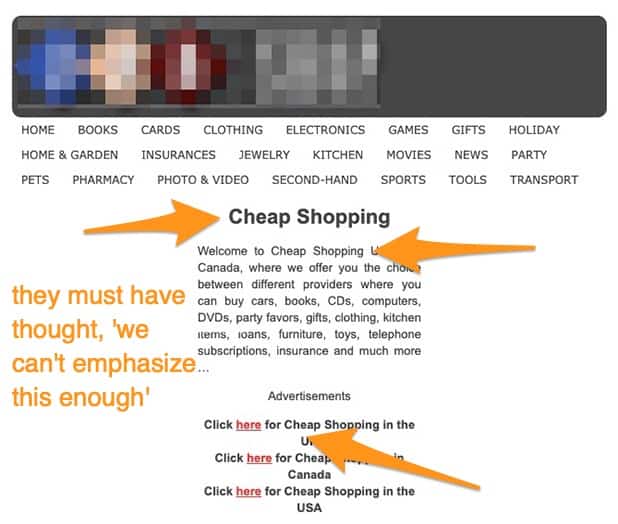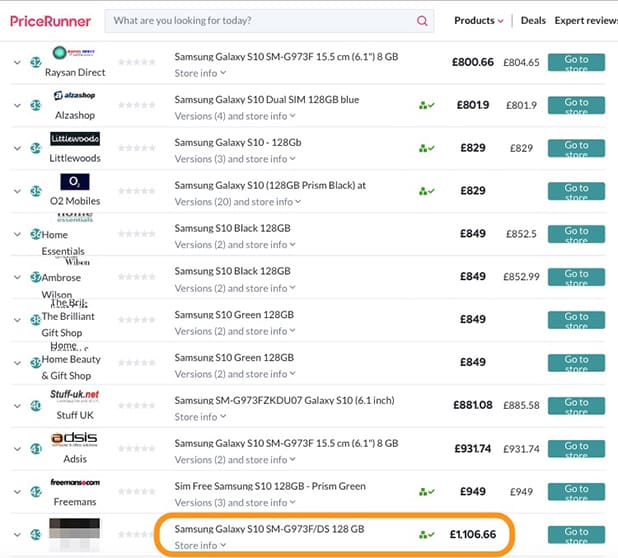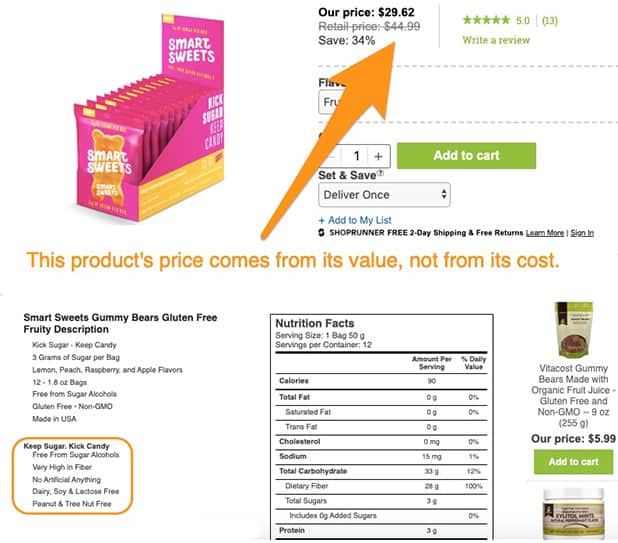We know that you are working hard to make the right decisions for your business. Sometimes managers stick to a strategy for so long that they are no longer able to see its shortcomings. They unwittingly fail the business objectives by insisting on wrong/defective tactics.
When it comes to your company’s pricing strategy, these mistakes can be very costly.
When you finish reading this post, you’ll learn the common pricing mistakes and what you need to do to avoid them.
Common pricing mistakes
Pricing too cheap
We always talk about the importance of competitive pricing for ecommerce businesses, and we stand by our statement. However, sometimes, decision-makers mistake competitive pricing for pricing too below the market average. It’s a grievous mistake that severely cuts into your profits.
Suppose you’re looking for a Samsung Galaxy S10 to buy.
Like any other shopper, you price search on a comparison shopping engine like the one below.

Of course, you’re going to choose the first option, which is what the store owner aims. Does it mean that it’s the right price this store should offer? Not exactly.
First of all, we’ve looked for the price offers from 43 stores, and they averaged at £750. Meaning, this store offers Samsung Galaxy S10 for £260 below its market average. This is a sign you should look for when pricing a product.
Since competitors insist on much higher prices, that means demand is still high at those price points.
Furthermore, if the price was £495, wouldn’t it still be the cheapest? Then why would the store owner cut the profits £15 per unit? There is no logical explanation.
Devaluing products/brand
When you see a seller of any kind who overemphasizes the cheapness of her products, you subconsciously assume the product quality is poor. Of course, being the cheapest destination for some products/categories is the best way to attract customers.

If you continuously overemphasize cheapness, people would appreciate neither the value nor the shopping experience you offer.
Instead, you can offer competitive prices and emphasize your unique selling proposition at the same time. That could be your excellent customer service, your unique product assortment, etc.
Pricing too expensive
In the harshly competitive ecommerce environment, there is no other option than competing on price. Let’s think about the opposite case of our example above.

What you see above is the highest price offering for the Samsung Galaxy S10. It’s more than double the cheapest offer, which was £479.
Put yourself in a customer’s shoes. Would you pay £1106 for it? Don’t think so. It’s highly likely that this seller doesn’t know how others price this product.
Either too cheap or too expensive, to avoid both, you have to track competitor prices.
Pricing based solely on cost
Cost-based pricing may be suited for some industries, but it surely isn’t for the ecommerce industry.
Nearly all online stores have direct competition, which means that their competitors sell the same products they do. The remaining few have indirect competition, meaning, they have competitors that sell substitute products.
We acknowledge the fact that even though two stores have identical product assortments, their business costs may turn out to be very different. So, one might figure, if my cost is much higher than my competitor’s, then I should be able to ask for a considerably higher price. You’re free to do so, but why would shoppers choose you?
Moreover, your product has more value than its cost. Think of two brands that sell fruits.
One is an organic brand, and the other one is not. Their overall costs are the same. What about their value to the shoppers that have health concerns? We know that organic food is more expensive than nonorganic food. The reason behind the difference is not their costs, but their value.

Sticky prices
Some marketers are reluctant to changing prices. What they give up is a great benefit of online retailing. In brick and mortar sales, price changes are both time-consuming and very costly.
Whereas in online retail, changing prices is a much easier process.
More importantly, it’s a necessity. We’ve talked about the importance of tracking competitor prices and make adjustments accordingly. That’s the only way to preserve your competitive strength.
On top of that, testing prices can drastically improve your sales. Even a $10 change can impact shoppers’ purchase decisions. That’s why you need to test different price points.
While on the other hand, sticky prices prevent you from testing various price points and making adjustments against competitor prices.
Quick takeaways
Your pricing strategy makes all the difference. Unfortunately, there are some serious misunderstandings about how a successful pricing strategy should be formulated. In this post, we’ve gathered the most common mistakes together and talked about why and how you can avoid them. These common pricing mistakes are:
- Pricing too below the market average, which results in an unnecessary cut in profit
- Devaluing product/brand by overemphasizing cheapness
- Pricing too above the market average, which will leave you out of the competition
- Sticky prices, which prevents you from testing price points to achieve the optimal price&demand balance



Leave a Reply